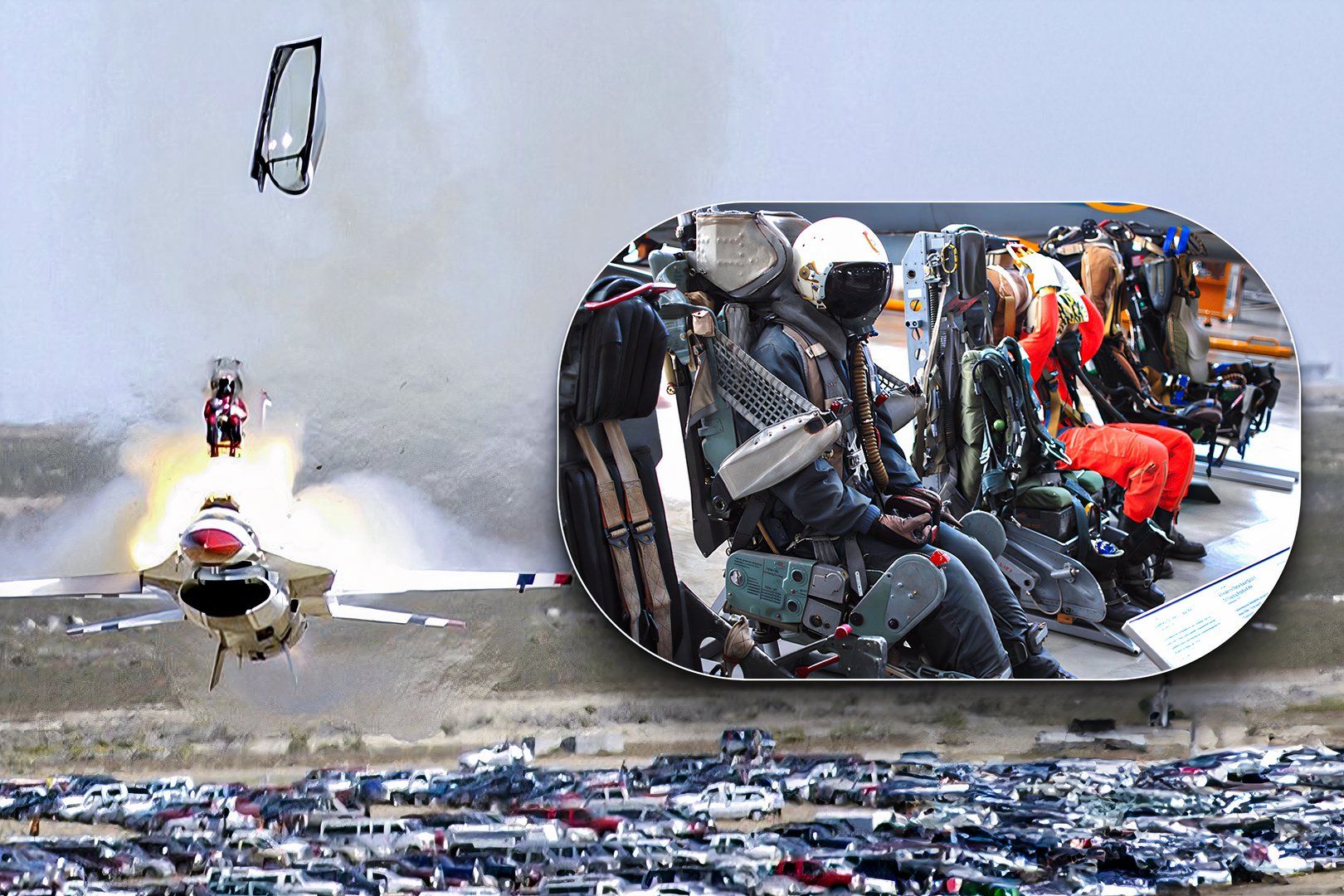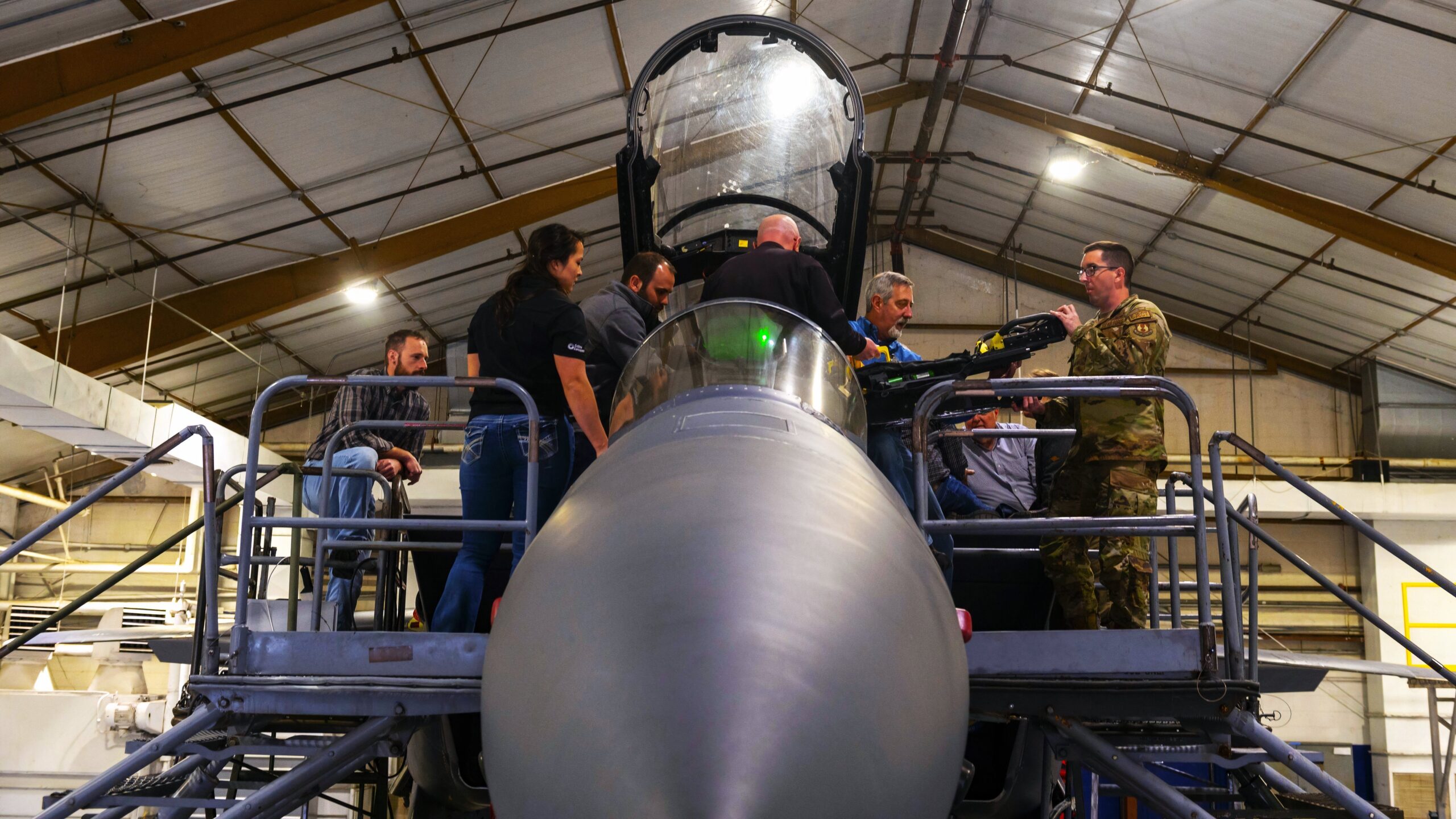Summary
- ACES 5 has new safety features like passive restraints and sensors for safe ejections
- Ejection seat must be armed on the ground, pilot-interface is complex, and it has saved 714 lives
- GR-7000 parachute ensures healthy pilot landing, and Grasshopper Club honors ejecting pilots
Recently, Simple Flying had the privilege of interviewing Andy Auer, Director of Marketing and Business Development for Ejection Seats at Collins Aerospace, about the ACES 5 ejection seat. The ACES 5 ejection seat has new safety features to reduce potential harm to an ejection seat user.
About the ACES 5 ejection seat
Collins Aerospace’s latest ejection seat offering, the ACES 5 ejection seat, is intended for all variants of the US Air Force and allied air forces’ F-15, F-16, B-1, B-2, and T-7 aircraft. Already, ACES 5 is being installed on the B-2 Spirit, and the latest model of F-15 in the F-15EX will be retrofitted with it after certification. In fact, the cover photos above and photo below are from a fit-test with the F-15E Strike Eagle on March 14, 2022.
Some may wonder why ACES 5 is for a name. ACES stands for Advance Concept Ejection Seat, while the 5 stands for the fifth ejection seat model built by Collins Aerospace. The ACES 2 model is the current seat in mass production but lacks the current safety features of the ACES 5, replacing the ACES 2, a circa 1978 design. The ACES 3 and 4 were test models.
As per the above brochure, the ACES 5 ejection seat has new safety features like passive head and neck projection and better passive leg and arm restraints. Today, pilots wear heavier helmets and equipment like night vision goggles or helmet-mounted sights, so head and neck restraints are needed. A lanyard will be cut during the ejection to trigger the deployment of passive restraints. Additionally, the seat has a safe ejection envelope with up to 600 knots of airspeed that can support aircrews weighing from 103 to 245 lbs., allowing a diverse range of aircrews to use the seats to eject and return home healthy.
The ACES 5 ejection seat also comes with sensors that can communicate the altitude and loads on the ejecting pilot to increase the probability of a safe ejection. For instance, the ACES 5 can sense the pilot’s weight and limit the rocket forces to protect the pilot’s spine while ensuring a safe separation from the aircraft. But how does this all work?
How does an ACES 5 ejection seat work?
The ACES 5 ejection seat must first be armed on the ground before it can fire. This prevents premature ejections, like last month with a Raytheon T-6 Texan II currently under investigation.
![7738154 (4x6) - Sheppard AFB Elephant Walk [Image 5 of 11] - T-6A Texan IIs](https://static1.simpleflyingimages.com/wordpress/wp-content/uploads/2024/05/7738154-4x6.jpg)
Related
US Air Force Instructor Dies After Ejection Seat Activates
The tragic loss of 80th Operations Support Squadron Capt. John Robertson prompts a discussion about ejection seats.
According to Andy Auer, Director of Marketing and Business Development for Collins Aerospace, only once the ACES 5 seat is armed can a pilot needing to eject pull the ejection handles. In most cases, the ACES 5 handles are either between the legs or along the sides of the seat. But pulling those handles only initiates a process. Below, one can see the complex process of an ACES 5 ejection seat:
One should note to quote Auer that,
“Our timing for our seats is in milliseconds. So, you know, once you pull the handle, it probably takes about three-quarters of a second to get out of the aircraft. That happens pretty quick, and our ACS to see has saved 714 lives to date.”
See, as Auer also kindly explained to Simple Flying, the seat starts to identify pressure, altitude, and wind speed with pitot tubes. This allows the ejection seat to choose the correct mode – whether low and slow, low and fast, high and slow, or high and fast to address altitude and speed conditions to preserve the pilot’s health. The mode is set, and the ejection seat starts to fire. The first rocket motor fires the seat; the second sustains the ejection. It ensures a clean separation from the aircraft, and the third rocket stabilizes the seat to prevent the pilot from getting tumbled and twisted.

Related
How Do Fighter Jet Ejection Seats Work?
Ejection seats are way more complicated than you might think, and even contain a survival kit.
Then, efforts are made to separate the pilot from the ejection seat. After all, falling in a metal seat is not necessarily suitable for a healthy landing. But the seat pans stay attached to the pilot. Why? The seat pan has additional survival equipment for the pilot to affect their own rescue.
Finally, to better guarantee a healthy landing, a larger parachute in the GR-7000 can reduce the falling pilot’s speed through the air to 15 knots and less than 21 feet per second. Additionally, this parachute can be steered to avoid trees, bodies of water, potential risks of capture, and such.
The Grasshopper Club
Finally, Collins Aerospace operates a special club for those pilots who must eject from an ACES seat. This club is the Grasshopper Club. As Collins Aerospace explains,
“To those who have done it, activating an ejection seat is very personal. They were faced with a split-second decision to be thrust out of an aircraft mid-flight or die. It is our honor to recognize their courage and bravery. The experience will stay with them forever.”
According to Auer, the club has 714 members, meeting biannually to share ejection stories to help Collins Aerospace employees understand the critical nature of their work.
What are your take-aways? Please share in the comments.


![7101921 - Ejection Seat Test Fitting [Image 1 of 8]](https://static1.simpleflyingimages.com/wordpress/wp-content/uploads/2024/06/7101921.jpg)